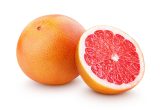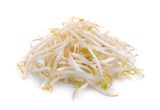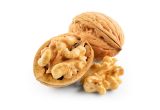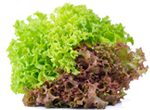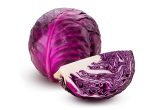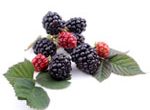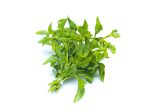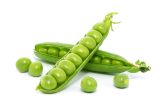Lemon

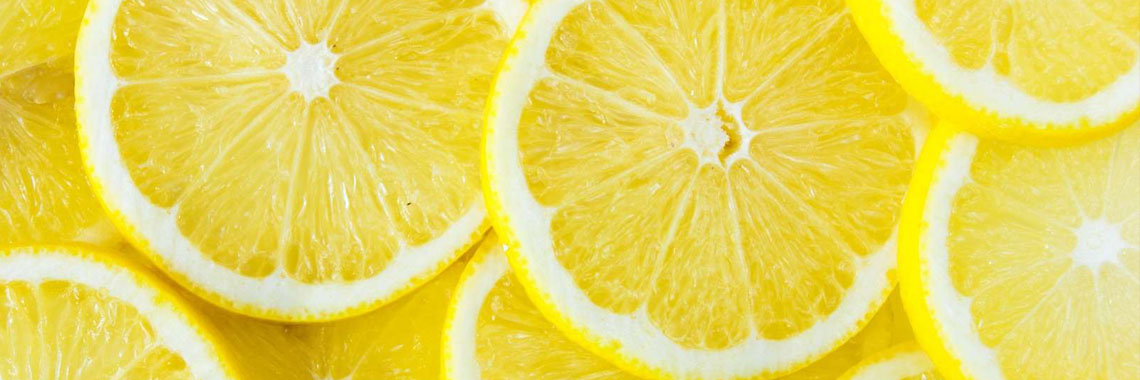
Description
- The lemon tree (Citrus limon L. Burm pp.) belongs to the Rutacea family. The main cultivars are Femminello Santa Teresa, Monachello and Femminello Continella (Settanni, 2014).
- The lemon tree is a small tree with glossy evergreen leaves. It is particularly present in India (Tomer, 2010).
PHYSICAL AND ORGANOLEPTIC CHARACTERISTICS
- Lemons are oblong or ovoid in shape and bright yellow in colour with a thick rind (Tomer, 2010).
- Their flesh is acidic and pale yellow in colour (Tomer, 2010).
- In citrus fruits, carotenoids are the pigments responsible for the external and internal colouring of the fruit. The composition and concentration of carotenoids are influenced by the growing conditions, geographical origins and ripeness of the fruit.
- Lemons and limes mainly contain β-cryptoxanthin (from the carotenoid family) and chlorophyll responsible for their yellow and green colour respectively (Zhang, 2012; Conesa, 2019).
- Throughout fruit ripening, chlorophyll degradation was observed, as well as an increase in β-cryptoxanthin (Conesa, 2019).
- The acidic taste is due to the presence of citric acid (Tomer, 2010). Lemons have a high concentration of organic acids (6.01 g per 100 g) (Ciqual Table, 2020), including 5.90 g of citric acid.
- The volatile compounds predominantly present in the juice are mainly monoterpenes, monoterpenoids and esters. Sesquiterpenes have been identified in the peel (Cano-Lamadrid, 2018). α-pinene, β-pinene, linalool and limonene are characteristic terpenes of lemon peel (Guadayol, 2018).
COMPOSITION CHARACTERISTICS (excluding macronutrients, vitamins and minerals)
- A study conducted on two lemon cultivars: Fino-49-5 and Fino-95, showed that weather conditions had a greater influence on the concentration of vitamin C and flavonoids in the fruit than the cultivar itself (Gonzales-Molina, 2008).
- The degree of ripeness of the fruit has an influence on the content of phenolic compounds (Dong, 2019).
- The health benefits of C. limon, recently scientifically demonstrated, include anti-inflammatory, antimicrobial, anticancer and antiparasitic activities. These effects are thought to be associated with the high content of phenolic compounds, mainly flavonoids and phenolic acids (Klimek-Szczykutowic, 2020).
- P-coumaric acid, ferulic acid, eriocitrin and hesperidin are reported to be the predominant phenolic compounds in the fruits of Citrus limon L. Burm (Dong, 2019).
- The antiplatelet activity of four compounds present in lemons of the Rutaceae family has been confirmed, namely oxypekedanine hydrate, citric acid, diosmin and limetin (Zhang, 2018).
RAW
The following values are approximate and depend on variety, season, ripeness, cultivation conditions, etc. Lemons are low in energy* as they provide an average of 27.60 calories (kcal) per 100 g, i.e. 118 kJ. According to the Ciqual 2020 table, lemons are the lowest calorie fruit.
One lemon weighs on average 120 g, meaning it provides 32.40 kcal.
COMPOSITION TABLES
For each nutrient, the tables provide information on the content, minimum and maximum values, as well as the percentage of the Dietary Reference Values (DRVs) per 100 g net of lemon.
*Regulation (EC) No 1924/2006 of the European Parliament and of the Council of 20 December 2006 on nutrition and health claims made on foods.
MACRONUTRIENTS
| Constituent (g) | Average content |
Min-Max per 100g |
DRV% |
|---|---|---|---|
| Water | 91,30 | - | - |
| Fibers | < 0,50 | NC - 1,20 | - |
| Carbohydrates | 1,56 | - | 0,60 |
| Sugars | 0,80 | NC - 3,20 | 0,89 |
| Lipids | < 0,50 | 0,30 - 1,10 | - |
| Saturated fat | < 0,01 | NC - 0,27 | - |
| Protein | < 0,50 | NC - 1,10 | - |
| Constituent (g) | Amount | Min-Max | DRV% |
|---|---|---|---|
| Water | Ciqual 2020 (valeur issue des analyses Ciqual-Aprifel 2017) | - | - |
| Fibers | Ciqual 2020 (valeur issue des analyses Ciqual-Aprifel 2017) | - | - |
| Carbohydrates | Ciqual 2020 | - | Règlement (UE) N°1169/2011 du parlement Européen et du conseil du 25 octobre 2011 |
| Sugars | Ciqual 2020 (valeur issue des analyses Ciqual-Aprifel 2017) | - | Règlement (UE) N°1169/2011 du parlement Européen et du conseil du 25 octobre 2011 |
| Lipids | Ciqual 2020 (valeur issue des analyses Ciqual-Aprifel 2017) | - | Règlement (UE) N°1169/2011 du parlement Européen et du conseil du 25 octobre 2011 |
| Saturated fat | Ciqual 2020 (valeur issue des analyses Ciqual-Aprifel 2017) | - | Règlement (UE) N°1169/2011 du parlement Européen et du conseil du 25 octobre 2011 |
| Protein | Ciqual 2020 (valeur issue des analyses Ciqual-Aprifel 2017) | - | Règlement (UE) N°1169/2011 du parlement Européen et du conseil du 25 octobre 2011 |
Zoom on carbohydrates
- Lemons contain a quantity of carbohydrates (1.56 g per 100 g) that is well below the average content found in fresh fruit (about 11.31 g per 100 g).
- These are mainly fructose (0.40 g per 100 g) and glucose (0.40 g per 100 g).
- Lemons are low in sugar* as they contain less than 5 g per 100 g.
Zoom on fibres
- Lemons contain less than 0.5 g of fibre per 100 g.
Zoom on proteins
- Lemons contain less than 0.5 g of protein per 100 g.
Zoom on lipids
- Lemons are fat-free* as they contain less than 0.5 g of fat per 100 g.
*Regulation (EC) No 1924/2006 of the European Parliament and of the Council of 20 December 2006 on nutrition and health claims made on foods.
MINERALS AND TRACE ELEMENTS
| Constituent | Average content |
Min-Max per 100g |
DRV% |
|---|---|---|---|
| Calcium (mg) | 11 | NC - 48 | 1,38 |
| Chloride (mg) | < 20 | - | - |
| Copper (mg) | 0,04 | 0,023 - 0,069 | 4 |
| Iron (mg) | 0,15 | 0,04 - 0,60 | 1,07 |
| Iodine (µg) | < 20 | 0,10 - NC | - |
| Magnesium (mg) | 7,90 | 7,30 - 10,90 | 2,11 |
| Manganese (mg) | 0,02 | NC - 0,04 | 1 |
| Phosphorus (mg) | 12 | NC - 28,50 | 1,71 |
| Potassium (mg) | 140 | 138 - 197 | 7 |
| Selenium (µg) | < 20 | 0,12 - NC | - |
| Sodium (mg) | < 5 | 2 - NC | - |
| Zinc (mg) | 0,33 | 0,05 - NC | 3,30 |
| Constituent | Amount | Min-Max | DRV% |
|---|---|---|---|
| Calcium (mg) | Ciqual 2020 (valeur issue des analyses Ciqual-Aprifel 2017) | - | Règlement (UE) N°1169/2011 du parlement Européen et du conseil du 25 octobre 2011 |
| Chloride (mg) | Ciqual 2020 (valeur issue des analyses Ciqual-Aprifel 2017) | - | Règlement (UE) N°1169/2011 du parlement Européen et du conseil du 25 octobre 2011 |
| Copper (mg) | Ciqual 2020 (valeur issue des analyses Ciqual-Aprifel 2017) | - | Règlement (UE) N°1169/2011 du parlement Européen et du conseil du 25 octobre 2011 |
| Iron (mg) | Ciqual 2020 (valeur issue des analyses Ciqual-Aprifel 2017) | - | Règlement (UE) N°1169/2011 du parlement Européen,et du conseil du 25 octobre 2011 |
| Iodine (µg) | Ciqual 2020 (valeur issue des analyses Ciqual-Aprifel 2017) | - | Règlement (UE) N°1169/2011 du parlement Européen et du conseil du 25 octobre 2011 |
| Magnesium (mg) | Ciqual 2020 (valeur issue des analyses Ciqual-Aprifel 2017) | - | Règlement (UE) N°1169/2011 du parlement Européen et du conseil du 25 octobre 2011 |
| Manganese (mg) | Ciqual 2020 (valeur issue des analyses Ciqual-Aprifel 2017) | - | Règlement (UE) N°1169/2011 du parlement Européen et du conseil du 25 octobre 2011 |
| Phosphorus (mg) | Ciqual 2020 (valeur issue des analyses Ciqual-Aprifel 2017) | - | Règlement (UE) N°1169/2011 du parlement Européen et du conseil du 25 octobre 2011 |
| Potassium (mg) | Ciqual 2020 (valeur issue des analyses Ciqual-Aprifel 2017) | - | Règlement (UE) N°1169/2011 du parlement Européen et du conseil du 25 octobre 2011 |
| Selenium (µg) | Ciqual 2020 (valeur issue des analyses Ciqual-Aprifel 2017) | - | Règlement (UE) N°1169/2011 du parlement Européen et du conseil du 25 octobre 2011 |
| Sodium (mg) | Ciqual 2020 (valeur issue des analyses Ciqual-Aprifel 2017) | - | - |
| Zinc (mg) | Ciqual 2020 (valeur issue des analyses Ciqual-Aprifel 2017) | - | Règlement (UE) N°1169/2011 du parlement Européen et du conseil du 25 octobre 2011 |
Zoom on minerals and trace elements
- Potassium is the mineral salt best represented in lemons, with an amount equivalent to 7% of DRVs, i.e. 140 mg per 100 g.
The other minerals and trace elements are present in smaller quantities. In fact, they each represent less than 5% of DRVs.
VITAMINS
| Constituent | Average content |
Min-Max per 100g |
DRV% |
|---|---|---|---|
| Provitamin A Beta-carotene (µg) | < 5 | 0 - NC | - |
| Vitamin A equivalent (µg) | < 0,83 | 0 - NC | - |
| Vitamin B1 (mg) | 0,043 | 0,34 - 0,06 | 3,91 |
| Vitamin B2 (mg) | < 0,01 | NC - 0,034 | - |
| Vitamin B3 (mg) | < 0,10 | NC - 0,23 | - |
| Vitamin B5 (mg) | 0,14 | NC - 0,23 | 2,33 |
| Vitamin B6 (mg) | 0,023 | NC - 0,10 | 1,64 |
| Vitamin B9 (µg) | 28,40 | 11 - 32 | 14,20 |
| Vitamin C (mg) | 45 | NC - 53 | 56,25 |
| Vitamin E (mg) | < 0,08 | NC - 0,80 | - |
| Vitamin K1 (µg) | < 0,80 | 0 - NC | - |
| Constituent | Amount | Min-Max | DRV% |
|---|---|---|---|
| Provitamin A Beta-carotene (µg) | Ciqual 2020 (valeur issue des analyses Ciqual-Aprifel 2017) | - | - |
| Vitamin A equivalent (µg) | Calcul à partir de la valeur Provitamine A Béta-carotène* | - | Règlement (UE) N°1169/2011 du parlement Européen et du conseil du 25 octobre 2011 |
| Vitamin B1 (mg) | Ciqual 2020 (valeur issue des analyses Ciqual-Aprifel 2017) | - | Règlement (UE) N°1169/2011 du parlement Européen et du conseil du 25 octobre 2011 |
| Vitamin B2 (mg) | Ciqual 2020 (valeur issue des analyses Ciqual-Aprifel 2017) | - | Règlement (UE) N°1169/2011 du parlement Européen et du conseil du 25 octobre 2011 |
| Vitamin B3 (mg) | Ciqual 2020 (valeur issue des analyses Ciqual-Aprifel 2017) | - | Règlement (UE) N°1169/2011 du parlement Européen et du conseil du 25 octobre 2011 |
| Vitamin B5 (mg) | Ciqual 2020 (valeur issue des analyses Ciqual-Aprifel 2017) | - | Règlement (UE) N°1169/2011 du parlement Européen et du conseil du 25 octobre 2011 |
| Vitamin B6 (mg) | Ciqual 2020 (valeur issue des analyses Ciqual-Aprifel 2017) | - | Règlement (UE) N°1169/2011 du parlement Européen et du conseil du 25 octobre 2011 |
| Vitamin B9 (µg) | Ciqual 2020 (valeur issue des analyses Ciqual-Aprifel 2017) | - | Règlement (UE) N°1169/2011 du parlement Européen et du conseil du 25 octobre 2011 |
| Vitamin C (mg) | Ciqual 2020 (valeur issue des analyses Ciqual-Aprifel 2017) | - | Règlement (UE) N°1169/2011 du parlement Européen et du conseil du 25 octobre 2011 |
| Vitamin E (mg) | Ciqual 2020 | - | Règlement (UE) N°1169/2011 du parlement Européen et du conseil du 25 octobre 2011 |
| Vitamin K1 (µg) | Ciqual 2020 (valeur issue des analyses Ciqual-Aprifel 2017) | - | Règlement (UE) N°1169/2011 du parlement Européen et du conseil du 25 octobre 2011 |
Zoom on vitamins
- Lemons are high in vitamin C as they provide the equivalent of 56.25% of DRVs, i.e. 45 mg per 100 g.
- They also contain a significant amount of vitamin B9, representing 14.20% of DRVs, i.e. 28.40 µg per 100 g.
- The other vitamins are present in quantities representing less than 4% of DRVs.
*Calculation made: Beta-Carotene / 6 + retinol
POLYPHENOLS
| Constituent (mg) | Average content |
Min-Max per 100mg |
|---|---|---|
| Flavonoids (mg) | 36,89 | 35,10 - 35,40 |
| of which Flavonols (mg) | 0,37 | 0 - 1,10 |
| of which Flavones (mg) | 1,27 | 0 - 2,31 |
| of which Flavanones (mg) | 35,25 | 35,10 - 35,40 |
| Lignanes (mg) | 0,02 | 0,02 - 0,02 |
| Total polyphenols | 36,91 | 35,12 - 38,83 |
| Constituent (mg) | Amount | Min-Max |
|---|---|---|
| Flavonoids | Phénol-Explorer version 3.6 Méthode utilisée : Chromatographie après hydrolyse | - |
| of which Flavonols | Phénol-Explorer version 3.6 Méthode utilisée : Chromatographie après hydrolyse | - |
| of which Flavones | Phénol-Explorer version 3.6 Méthode utilisée : Chromatographie après hydrolyse | - |
| of which Flavanones | Phénol-Explorer version 3.6 Méthode utilisée : Chromatographie après hydrolyse | - |
| Lignanes | Phénol-Explorer version 3.6 Méthode utilisée : Chromatographie après hydrolyse | - |
| Total polyphenols | Phénol-Explorer version 3.6 Méthode utilisée : Chromatographie après hydrolyse | - |
Zoom on polyphenols
- Polyphenols are substances with an antioxidant effect.
Lemon contains a notable quantity of total polyphenols. They are essentially flavanones, from the flavonoid family.
Nutrition and health claims
According to the definitions of nutrition claims as set out in Regulation (EC) No 1924/2006 on nutrition and health claims, and in view of the composition of lemons, the following claims may be used:
NUTRITION CLAIMS OF LEMONS
- Low in energy (100 g of lemon provide less than 40 kcal)
- Fat-free (100 g of lemon contain less than 0.5 g of fat)
- Low in sugar (100 g of lemon contain less than 5 g of sugar)
- High in vitamin C (100 g of lemon provide the equivalent of more than 30% of DRVs)
HEALTH CLAIMS (for a consumption of 100 g of lemon)
Vitamin C
- Vitamin C contributes to:
- normal function of the immune system during and after intense physical exercise,
- normal collagen formation for the normal function of blood vessels,
- normal collagen formation for the normal function of bones,
- normal collagen formation for the normal function of cartilage,
- normal collagen formation for the normal function of gums,
- normal collagen formation for the normal function of skin,
- normal collagen formation for the normal function of teeth,
- normal energy-yielding metabolism,
- normal functioning of the nervous system,
- normal psychological function,
- normal function of the immune system,
- protection of cells from oxidative stress,
- reduction of tiredness and fatigue,
- regeneration of the reduced form of vitamin E.
- Vitamin C increases iron absorption.
References
- Afssa, 2002. Les fibres alimentaires : définitions, méthodes de dosage, allégations nutritionnelles
- Bourgou S, Rahali FZ, Ourghemmi I, Saïdani Tounsi M. Changes of peel essential oil composition of four Tunisian citrus during fruit maturation. ScientificWorldJournal. 2012;2012:528593.
- González-Molina E, Moreno DA, García-Viguera C. Genotype and harvest time influence the phytochemical quality of Fino lemon juice (Citrus limon (L.) Burm. F.) for industrial use. J Agric Food Chem. 2008 Mar 12;56(5):1669-75.
- Neveu V, Perez-Jiménez J, Vos F, Crespy V, du Chaffaut L, Mennen L, Knox C, Eisner R, Cruz J, Wishart D, Scalbert A. (2010) Phenol-Explorer: an online comprehensive database on polyphenol contents in foods. Database, doi: 10.1093/database/bap024. Full text (free access)
- Règlement (CE) N° 1924/2006 du Parlement européen et du Conseil du 20 décembre 2006 concernant les allégations nutritionnelles et de santé portant sur les denrées alimentaires.
- Règlement (UE) N°432/2012 de la Commission du 16 mai 2012 établissant une liste des allégations de santé autorisées portant sur les denrées alimentaires, autres que celles faisant référence à la réduction du risque de maladie ainsi qu’au développement et à la santé infantiles.
- Règlement (UE) n°1169/2011 du Parlement européen et du Conseil du 25 octobre 2011 concernant l’information des consommateurs sur les denrées alimentaires, modifiant les règlements (CE) n°1924/2006 et (CE) n°1925/2006 du Parlement européen et de Conseil et abrogeant la directive 87/250/CEE de la Commission, la directive 90/496/CEE du Conseil, la directive 1999/10/CE de la Commission, la directive 200/13/CE du Parlement européen et du Conseil, les directives 2002/67/CE et 2008/5/CE de la Commission et le règlement (CE) n°608/2004 de la Commission.
- Rothwell JA, Urpi-Sarda M, Boto-Ordoñez M, Knox C, Llorach R, Eisner R, Cruz J, Neveu V, Wishart D, Manach C, Andres-Lacueva C, Scalbert A. (2012) Phenol-Explorer 2.0: a major update of the Phenol-Explorer database integrating data on polyphenol metabolism and pharmacokinetics in humans and experimental animals. Database, doi: 10.1093/database/bas031. Full text (free access)
- Rothwell JA, Pérez-Jiménez J, Neveu V, Medina-Ramon A, M’Hiri N, Garcia Lobato P, Manach C, Knox K, Eisner R, Wishart D, Scalbert A. (2013) Phenol-Explorer 3.0: a major update of the Phenol-Explorer database to incorporate data on the effects of food processing on polyphenol content. Database, 10.1093/database/bat070. Full text (free access)
- Settanni L, Randazzo W, Palazzolo E, Moschetti M, Aleo A, Guarrasi V, Mammina C, San Biagio PL, Marra FP, Moschetti G, Germanà MA. Seasonal variations of antimicrobial activity and chemical composition of essential oils extracted from three Citrus limon L. Burm. cultivars. Nat Prod Res. 2014 Mar;28(6):383-91.
- Table de composition nutritionnelle des aliments CIQUAL (2017) – via le site internet www.anses.fr, consultée le 11/12/2017.
- Tomer K, Sethiya NK, Shete A, Singh V. Isolation and characterization of total volatile components from leaves of citrus limon linn. J Adv Pharm Technol Res. 2010 Jan;1(1):49-55.
- Zhang L, Ma G, Kato M, Yamawaki K, Takagi T, Kiriiwa Y, Ikoma Y, Matsumoto H, Yoshioka T, Nesumi H. Regulation of carotenoid accumulation and the expression of carotenoid metabolic genes in citrus juice sacs in vitro. J Exp Bot. 2012 Jan;63(2):871-86.




